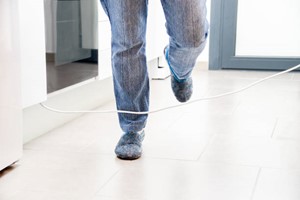Avoid Slips, Trips, and Falls at Work

Slips, trips, and falls are some of the leading causes of workplace accidents, emergency room visits, and workers’ compensation claims. Injuries range from minor bruises to severe traumas and unfortunately, falls cause fatalities, as well.
These accidents are largely preventable by following these tips.
Slips are a loss of balance caused by too little friction between your feet and the surface you’re walking on, and they’re often caused by wet surfaces, spills, or weather hazards like ice or snow. You’re more likely to slip when you hurry or run, don’t wear the proper kind of shoes or fail to pay attention where you’re walking.
- Take short steps on slippery surfaces to keep your center of balance, and point your feet at a 45º–walking almost like a penguin.
- Clean or report any spills immediately, major or minor.
- Don’t let grease accumulate anywhere, and be extra careful while walking on smooth surfaces like newly waxed floors and loose carpeting.
Trips happen when your foot hits an object and you have enough momentum to be thrown off balance. If you catch your foot on something, especially while walking at an increased pace, you’re more than likely to trip over it and get injured. To steer clear of injury (and embarrassment):
- Make sure you can always see where you’re walking and don’t carry loads that block your eyesight.
- Walk and work in well-lit areas, especially at night.
- Keep your workplace clean and tidy and arrange furniture/office equipment so that it doesn’t interfere with walkways or foot traffic.
- Properly maintain walking and working areas and alert the proper workers regarding any maintenance-related hazards.
Falls occur whenever you get too far off of your center of balance, and is perhaps the most injury-inducing action out of slips, trips, and falls. The good news is, it’s also the most preventable–with planning ahead, assessing any risks, and using the right equipment.
- Discuss the task with coworkers and determine what safety equipment will be needed. Make sure you are properly trained on the equipment, and that the equipment is undamaged.
- Analyze the workspace for any potential hazards, make sure the ground is level for setting up equipment, and use the correct tool for the job.
- Checking the weather beforehand is helpful, too.
If using a stepladder, ensure that it has a locking device to hold the front and back open, and always keep two hands and one foot, or two feet and one hand on the ladder.
- Place the ladder on a solid surface, making sure to never lean it against anything unstable.
- A straight or extension ladder should be 1 foot away from the surface it’s resting on for ever 4 feet of height and extend at least 3 feet over the top edge.
- Fasten straight and extension ladders to an upper support.
- Wear slip-resistant shoes.
- Don’t stand higher than the third rung, and never lean or reach while on a ladder.


